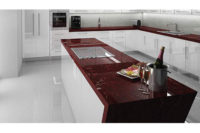Over the past few years, this line of thinking has changed — particularly when it comes to quartz surfacing. This change in attitude is not only in my view, but in the view of many long-time stone fabricators. I can think of many shops that said, “You won’t catch me processing that stuff,” only five years ago, and now quartz surfacing makes up a large percentage of their business.
From what I have studied over the past few years, there are several factors for this shift. Among them, the manufacturers of quartz surfacing are offering products that are more innovative than ever before. If a customer wants a “stone-look” material, but they don’t want to see the occasional “oddball” vein here and there, the manufacturers can offer it to them. If they want a color not found in nature — dark blue, bright red, etc. — that’s out there as well. Quartz surfacing manufacturers can even create custom colors for a project, as we have seen in some of the professional sports venues covered in Stone World over the past few years, many of which utilize material in colors that perfectly match the team’s uniforms.
Taking this to another level, many producers of quartz surfacing have created products using recycled content, including post-consumer materials such as mirrors, glass, bottles and porcelain from china, tiles, sinks, toilets and decorative elements. An example of this can be found in this issue, as an article on the home of uber-environmentalist Robert F. Kennedy, Jr. details his use of slabs that were created using recycled post-consumer content (page 110).
When I walked the halls of the Stone+tec fair in Nuremberg, Germany, during the early part of this past summer, I of course noticed the broad range of natural stone materials on the show floor. Stone quarriers are continually tapping new resources for natural stone, and this allows them to introduce dazzling new materials as well as to develop new sites for classic, popular stones.
But perhaps more than ever, I also saw a high level of advancement in the area of quartz surfacing. Producers are developing new colors, textures and shapes on a continual basis, and a small sampling of these can be seen in our Stone+tec review on page 76 of this issue.
Moreover, it seems that whenever a producer of quartz surfacing opens a new facility, they do so using the finest equipment in the world. An example of this can be seen on page 62 of this issue, as a new producer of quartz surfacing in Turkey is establishing itself by opening a plant with state-of-the-art technology.
Of course, the bottom line is what end users are asking for, and the fact is that too many customers are asking for quartz surfacing for us to be “purists” anymore. As one long-time fabricator said to me, “In this day and age, I can’t really say to someone, ‘No, I refuse to cut that material.’ I don’t think anyone is in a position to be turning business away right now.”
As the Greek philosopher Heraclitus once said, “The only constant is change,” and that also applies to our industry. Things are changing every day, including the “stones” being processed in fabrication shops. (OK, I don’t really know Greek philosophy; I looked up the quote on the Internet, but the point is still valid.)



